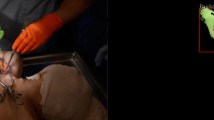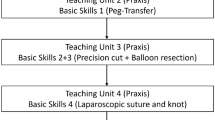Abstract
Purpose
Increasing pressure pushes towards the objective competence assessment of clinical operators. Hand motion analysis (HMA) was introduced to measure surgical and clinical procedures; its recent application to FAST examinations leaves unsolved issues. This study aimed at determining optimal HMA parameters to discriminate between operators’ skill levels, and which FAST tasks are experience-dependent.
Methods
Ten experienced (EG) and 13 beginner (BG) sonographers performed a FAST examination on one female and one male model. A motion capture system returned the duration, working volume, number of movements (absolute and time normalized), and hand path length (absolute and time normalized) of each view.
Results
BG took more time in completing specific views, with a higher working volume (p = 0.003) and longer hands path (p < 0.001). The number of movements was lower in the EG (p < 0.001) and differed between views (p = 0.014). No significant Group/Model differences were found for the normalized number of movements. The LUQ view required a higher number of movements (p < 0.001).
Conclusions
HMA identified kinematic parameters discriminating between proficiency level and critical subtasks in the FAST examination. These findings could be the base for a focused HMA-based evaluation of performances following a proctored training period. There is room to incorporate HMA into simulation metrics and evidence-based credentialing standards for clinical ultrasound applications.




Similar content being viewed by others
References
Dosis A, Aggarwal R, Bello F, Moorthy K, Munz Y, Gillies D, et al. Synchronized video and motion analysis for the assessment of procedures in the operating theater. Arch Surg. 2005;140:293–9.
Glarner CE, Hu YY, Chen CH, Radwin RG, Zhao Q, Craven MW, et al. Quantifying technical skills during open operations using video-based motion analysis. Surgery. 2014;156:729–34.
McGoldrick RB, Davis CR, Paro J, Hui K, Nguyen D, Lee GK. Motion analysis for microsurgical training: objective measures of dexterity, economy of movement, and ability. Plast Reconstr Surg. 2015;136:231e–240e.
Grober ED, Roberts M, Shin EJ, Mahdi M, Bacal V. Intraoperative assessment of technical skills on live patients using economy of hand motion: establishing learning curves of surgical competence. Am J Surg. 2010;199:81–5.
Sgouros NP, Loukas C, Koufi V, Troupis TG, Georgiou E. An automated skills assessment framework for laparoscopic training tasks. Int J Med Robot Comput Assist Surg. 2018;14:1–10.
D’Angelo A-LD, Rutherford DN, Ray RD, Laufer S, Mason A, Pugh CM. Working volume: evaluating validity evidence of a new measure of surgical efficiency. Am J Surg. 2016;211(2):445–50.
Ziesmann MT, Park J, Unger B, Kirkpatrick AW, Vergis A, Pham C, et al. Validation of hand motion analysis as an objective assessment tool for the focused assessment with sonography for trauma examination. J Trauma Acute Care Surg. 2015;79:631–7.
Zago M. Time for a comprehensive ultrasound-enhanced trauma management. Eur J Trauma Emerg Surg. 2009;35:339–40.
Padalino P, Bomben F, Chiara O, Montagnolo G, Marini A, Zago M, et al. Healing of blunt liver Injury after non-operative management: role of ultrasonography follow-up. Eur J Trauma Emerg Surg. 2009;35:364–70.
Jeanmonod R, Stawicki SP, Bahner DP, Zago M. Advancing clinician-performed sonography in the twenty-first century: building on the rich legacy of the twentieth century pioneers. Eur J Trauma Emerg Surg. 2016;42:115–8.
Sahlani L, Thompson L, Vira A, Panchal AR. Bedside ultrasound procedures: musculoskeletal and non-musculoskeletal. Eur J Trauma Emerg Surg. 2016;42:127–8.
Lewis GC, Crapo SA, Williams JG. Critical skills and procedures in emergency medicine. Vascular access skills and procedures. Emerg Med Clin N Am. 2013;31:59–86.
Ratnasekera A, Ferrada P. Ultrasonographic-guided resuscitation of the surgical patient. JAMA Surg. 2018;153:77–8.
Pereira J, Afonso AC, Constantino J, Matos A, Henriques C, Zago M, et al. Accuracy of ultrasound in the diagnosis of acute cholecystitis with coexistent acute pancreatitis. Eur J Trauma Emerg Surg. 2017;43:79–83.
Ziesmann MT, Park J, Unger BJ, Kirkpatrick AW, Vergis A, Logsetty S, et al. Validation of the quality of ultrasound imaging and competence (QUICk) score as an objective assessment tool for the FAST examination. J Trauma Acute Care Surg. 2015;78:1008–13.
Zago M, Martinez Casas I, Pereira J, Mariani D, Silva AR, Casamassima A, et al. Tailored ultrasound learning for acute care surgeons: a review of the MUSEC (Modular UltraSound ESTES Course) project. Eur J Trauma Emerg Surg. 2016;42:161–8.
Annet M. Subgroup handedness and the probability of nonright preference for foot or eye and of a nonright-handed parent. Percept Mot Skills. 2001;93(3):911–4.
Todsen T, Tolsgaard MG, Olsen BH, Henriksen BM, Hillingsø JG, Konge L, et al. Reliable and valid assessment of point-of-care ultrasonography. Ann Surg. 2015;261:309–15.
Matyal R, Mitchell J, Hess P, Chaudary B, Bose R, Jainandunsin J, et al. Simulator-based transesophageal echocardiographic training with motion analysis: a curriculum-based approach. Anesthesiology. 2014;121:389–99.
Clinkard D, Holden M, Ungi T, Messenger D, Davison C, Fichtinger G, et al. The development and validation of hand motion analysis to evaluate competency in central line catheterization. Acad Emerg Med. 2015;22:212–8.
Chmarra MK, Klein S, De Winter JCF, Jansen FW, Dankelman J. Objective classification of residents based on their psychomotor laparoscopic skills. Surg Endosc Other Interv Tech. 2010;24:1031–9.
Datta V, Mackay S, Mandalia M, Darzi A. The use of electromagnetic motion tracking analysis to objectively measure open surgical skill in the laboratory-based model. J Am Coll Surg. 2001;193:479–85.
Hassan EA, Jenkyn TR, Dunning CE. Direct comparison of kinematic data collected using an electromagnetic tracking system versus a digital optical system. J Biomech. 2007;40:930–5.
Funding
The author received no specific funding for this work.
Author information
Authors and Affiliations
Corresponding author
Ethics declarations
Conflict of interest
The authors have declared that no competing interests exist.
Rights and permissions
About this article
Cite this article
Zago, M., Sforza, C., Mariani, D. et al. Educational impact of hand motion analysis in the evaluation of FAST examination skills. Eur J Trauma Emerg Surg 46, 1421–1428 (2020). https://doi.org/10.1007/s00068-019-01112-6
Received:
Accepted:
Published:
Issue Date:
DOI: https://doi.org/10.1007/s00068-019-01112-6




